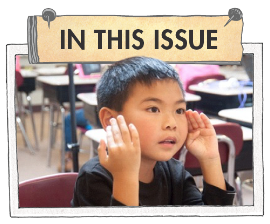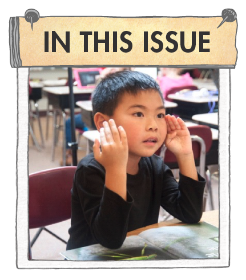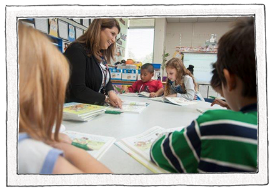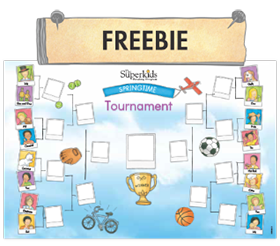|
|
|
|
ISSUE 18 | MAR. 2021
|
 
|
|
Reading with comprehension means understanding what you’re reading. Right from the beginning, children need to be taught that the goal of reading is to understand the ideas and events that the written words tell about. Teaching children specific skills and strategies improves their reading comprehension. Modeling and guided practice with strategies show children how good readers think about and make sense of text. Over time, children need to use strategies when reading on their own. The more adept they become at applying a variety of comprehension skills and strategies, the more tools they have to help them make meaning of any text they read.
|
|
|
|
There are many factors that affect a reader’s comprehension. In this issue, we will focus on a few of these factors and how to use Superkids lessons and materials to teach and improve comprehension skills.
|
|
|
|
|
|
|
|
|
| Comprehension is an integral part of the instruction in The Superkids Reading Program. The instruction in the reading lessons helps build children’s background before reading, guide comprehension during reading, and engage children in discussion about the text after reading.
|
| • |
Before reading, you will support comprehension by activating prior knowledge and building background knowledge, previewing the text, discussing key vocabulary, and setting purpose for reading.
|
|
|

|
| • |
During reading, ask the comprehension questions that are provided in the lessons. Children will discuss and answer the questions, while using evidence from the text to support their answers. Be sure to use the think-alouds included in lessons to model for students what good readers do in their heads as they read. |
| • |
After reading, discussions provide further opportunities to assess children’s understanding by asking them to summarize or retell what they have read. This is also the time to dig more deeper into direct instruction of strategies used to comprehend the text. |
|

|
|
|
Tip: The Resources section of the Superkids Skill-Building Book includes many graphic organizers to further support students’ understanding of text. These can be photocopied, displayed on an interactive whiteboard, or shared with a document camera during remote instruction. You could also draw your own on chart paper.
|
|
|
|
|
|
In order to comprehend text, children must have the skills needed to decode words. When children have to work hard to decode words, they have little attention left for comprehending the text they are reading. Fluency in word recognition frees up the reader’s brain energy to focus on comprehension. Research is clear that word recognition automaticity is highly correlated with good reading comprehension.
If a child is struggling with comprehension, the problem might stem from a lack of automaticity with decoding. In this case, providing additional decoding or fluency practice would best address the student’s instructional needs. Activities to support decoding and fluency skills can be found in the Ten-Minute Tuck-Ins section of each lesson and in the Superkids Skill-Building Book.
|
|
|
|
|
|

|
Tip: When working with children who read in a slow, halting manner, it is difficult for them to follow the meaning of what they are reading. During small-group reading lessons, if children struggle with reading a page, read the text again aloud to the group, smoothly and fluently, so they can concentrate on the meaning of the text.
Tip: If you have a small group of struggling readers, you can read several pages or the whole text aloud to the group first. Discuss comprehension questions with them during and after the oral reading. Then select a section of text for them to individually practice decoding and reading aloud.
|
|
|
|
|
|

|
|
|
|
|
|
|
|
Vocabulary development is integrated into every aspect of Superkids as children at all levels discuss words from stories, shared writing, classroom conversations, and Daily Routines for decoding and spelling.
Explicit vocabulary instruction occurs before, during, and after children listen to or read text. Words important to understanding the text—both those used directly in the text as well as concept words needed to discuss it—are introduced and discussed before the text is read. Other words and idioms are discussed in context during reading and then expanded to other contexts after reading.
|
|
Teaching vocabulary will build students’ background knowledge and directly aid their comprehension. For additional practice, you will often find activities to reinforce new vocabulary in the Ten-Minute Tuck-Ins section of the lesson.
Tip: Along with teaching vocabulary in lessons, you can help children learn new words every day in simple ways that are fun. Here are a few ideas:
|
|
| • |
After teaching vocabulary in the story and story follow-up lessons, find opportunities to bring up the new words in daily conversation in the classroom. Encourage children to do the same. Multiple exposures to new words help children learn the words. |
| • |
Read aloud regularly from a variety of fiction and nonfiction books and discuss the meaning of words as you read. See the lists of suggested books for read-aloud in the Teacher’s Guides and on the Teacher Portal.
|
| • |
Post or say a “Word of the Day” and challenge children to figure out its meaning. Give hints throughout the day. |
| • |
Discuss things in the classroom and objects you or students bring from home. Besides naming the items, have children describe them and talk about how they’re used. Identify categories that the items belong to and other items that fit in the categories.
|
|
|
|
|
|
|
Zaner-Bloser recently announced a partnership with Listenwise for the elementary grades. This award-winning platform brings podcasts to the classroom. Talk about a great way to build listening comprehension in school or remotely!

|
|
|
|
|
|

|
|
|
|

|
|
|
|
|
|
|
|
As promised, here is the 2021 Spring Tournament bracket!
Beginning on March 11, we will post a daily head-to-head poll on our Facebook page matching characters in a scenario featuring a favorite sport or activity of the Superkids. Teachers will ask their class to vote on who they predict would win the match and use the poll to cast their class vote. You can use the bracket to keep track of who came out on top in the daily poll, or you can run your own tournament with the students.
|
|
|
|
|

|
|
|
|
|